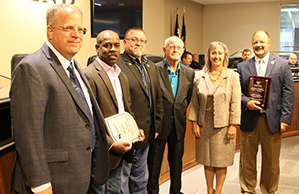Garland’s Duck Creek Wastewater Treatment Plant recently received two awards from the Water Environment Association of Texas.
Duck Creek Wastewater Treatment Plant received the George Burke Jr. Award, which honors municipal and industrial wastewater facilities for active and effective safety programs at the national level. During 2015, 2016 and 2017, there were zero lost time incidents.
Duck Creek Wastewater Treatment Plant also received WEAT’s 2018 Municipal Wastewater Treatment Plant of the Year Award (Category 3 – Greater than 15 Million Gallons per Day). The Treatment Plant of the Year was awarded for 100 percent environmental compliance and operational safety. This award recognizes the facilities for excellence in wastewater treatment as measured by their compliance with their National Pollutant Discharge Elimination System (NPDES) permits. For Duck Creek, this encompasses more than 4,000 permit parameters per year. This award is given to a plant that has consistently exhibited outstanding performance of daily activities beyond the normal call of duty.
These awards demonstrate the hard work of every treatment employee and their commitment to being good stewards of the environment.
Pictured left to right: Wastewater Director Bill Gase, Plant Operator Earl Gibson, Plant Supervisor Alex Stuart, Plant Maintenance Supervisor Don Dudley, Mayor Lori Dodson and Water Utilities Managing Director Wes KucerPictured left to right: Wastewater Director Bill Gase, Plant Operator Earl Gibson, Plant Supervisor Alex Stuart, Plant Maintenance Supervisor Don Dudley, Mayor Lori Dodson and Water Utilities Managing Director Wes Kucera
About: The Duck Creek Wastewater Treatment Plant is an Activated Sludge and Trickling Filter/Solids Contact (TF/SC) plant permitted to treat 40 million gallons per day. The Texas Commission on Environmental Quality limits discharge of treated wastewater that contains less than 10 milligrams per liter (mg/L) of carbonaceous biochemical oxygen demand, 15 milligrams per liter (mg/L) total suspended solids, and seasonal ammonia nitrogen limits of 5 milligrams per liter (mg/l) (December – March) and 2 milligrams per liter (mg/l) (April – November). During 2015, the average daily results were: 2.4 mg/L carbonaceous biochemical oxygen demand, 3.5 mg/L total suspended solids, and seasonal ammonia nitrogen 0.6 mg/L December – March and 0.5 mg/L April – November.
Information and photo provided by city of Garland.


